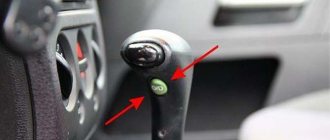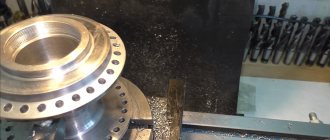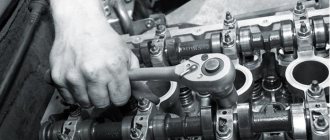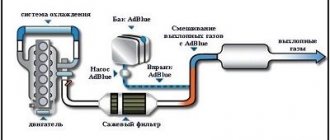As you know, the main purpose of the transmission is to transmit torque from the engine to the drive wheels. At the same time, the transmission not only transmits, but also converts torque. Most drivers know that a manual transmission has low and high gears. Conventionally, 1,2 and 3 can be considered reduced, 4 is considered to be direct transmission, while 5 and 6 are increased.
Let us immediately note that in relation to SUVs, trucks and various types of equipment, such a conditional division is not enough. The fact is that the gearboxes on such cars have not only “low” and “high” gears, but also so-called downshifts. Next, we'll look at why downshifting is needed, what it is and how it works, and how to use downshifting.
Types of reduction gears
Worm, less often cylindrical and planetary gears are used as reduction gears. The worm gear is one of the gearing gears with intersecting shaft axes. Movement in them is carried out according to the principle of a screw pair. Its main properties are low noise level due to the characteristics of the gearing, relatively low efficiency, small dimensions and large gear ratio. Compared to a helical gearbox, a worm gear provides better running smoothness. This type of transmission has a much greater potential for increasing torque and reducing rotation speed than gearboxes with other types of gears. Spur gears are used in mechanisms with parallel shafts. This type requires increased accuracy due to design features.
Gear drives are distinguished by their reliability and durability while maintaining the permissible load level; the disadvantages include the fact that at high rotation speeds such a mechanism has a high noise level and also cannot flexibly respond to changing loads. Planetary gears are also a type of gear. They have gears with movable axles. Such gears are lightweight, easy to assemble, produce less noise compared to conventional gears, and also have the ability to obtain large gear ratios. Disadvantages include a large number of parts, increased requirements for installation and manufacturing accuracy.
Demultiplier as part of the turning mechanism of a tracked vehicle [edit | edit code]
Some types of planetary turning mechanisms for tracked vehicles, the design of which includes two two-speed differential gearboxes, make it possible to implement the range-multiplier function through simultaneous group (paired) switching of both gearboxes from one operating mode to another - from high gear to low gear. In this case, as in the case of the range multiplier that is part of the gearbox, the output torque increases with a simultaneous decrease in rotation speed. This option is only a consequence of the ability of such turning mechanisms to provide two gear ratios for maneuvering and is not formally a range-multiplier, although it can be used like one.
Contrary to the widespread belief that there is a range option in the turning mechanisms of the vast majority of tracked vehicles, in fact it was present only on relatively old vehicles: British Cavalier, Covenanter, Crusader tanks; Czech tank LT vz.38; Hungarian Turan tank; Japanese tank 三式中戦車 (Chi-Nu); Soviet tanks IS-1, IS-2, IS-3, T-44, T-54, T-55, T-62; Soviet combat vehicles BMP-1, BMP-2; Soviet tracked tractor AT-S. Also, some little-used dual-flow turning mechanisms on modern vehicles, similar to those on the Panther tank, have a similar option: the Panther itself, the Soviet AT-L tracked tractor, the Soviet MT-LB and MT-LBu tracked combat vehicles.
First of all, let's say that the gears of any transmission are designed to regulate the speed of transmission of torque from the engine to the drive wheels. They are divided into direct ones, as well as those that increase torque and decrease it. Here we will talk in more detail about the latter type.
Turn on the "lower"
By starting a low-range gear, a large torque is transmitted to the wheel drive. As a result, difficult roads can be overcome without serious load on the engine.
This mode is not the only one on modern machines. The driver can also select other operating modes. You can save fuel while traveling on highways by switching the gearbox to high-speed operation. We often encounter the problem of traffic jams; in such a situation, it is logical to switch the gearbox to a mode not exceeding first gear. Typically this setting is used when driving at low speeds.
Do I need to change tire pressure in winter?
The first snow has already fallen in the Moscow region, more will follow, so novice jeepers will probably be tormented by the question, what to do with tire pressure? To reduce it or not.
The answer is:
You don't need to do anything. Leave the pressure the same, the snow chains are more important here. Therefore, if you go winter fishing or for some business to a snowy field, be sure to take chains with you.
The next time you find yourself far from the road, remember this reminder. By engaging all-wheel drive in time, you have less chance of getting stuck and will emerge victorious from the mud or deep snow.
The design of the transmission of many cars includes such a unit as a transfer case. Thanks to it, the drive on such cars is carried out on all wheels. The presence of a transfer case increases the vehicle's maneuverability and improves handling. This additional unit is equipped with both regular passenger cars and all-terrain models - SUVs and crossovers.
Gear housings
Standardized cast gearbox housings are widely used in mass production. Most often, in heavy industry and mechanical engineering, housings are made of cast iron, less often of cast steel. When it is necessary to make the design as light as possible, light alloy bodies are used. The gearbox housing most often has attachment points - paws and/or ears, by which the gearboxes are moved and/or secured to the base. At the output of the shafts, seals are placed to prevent oil leakage. Structural elements are often placed on the gearbox housings to prevent an increase in pressure inside the gearbox resulting from the heating of the gearbox during operation.
Low gear - functionality features
Gear housing
The crawler gearbox is available on both manual and automatic SUVs. The classic solution with a separate gearbox is not available in all cars, especially in new types. If there is no gearbox, you need to shift down using a special lever or button (in modern cars). Why is a transfer case not installed on seemingly full-fledged SUVs? This makes the car heavier and more expensive. In search of efficient and economical solutions, many SUVs are not equipped with a transfer case. Even older models sometimes don't have it. Take, for example, the LUAZ - it has front-wheel drive, the rear is connected directly through the gearbox. However, the truck only moves forward in low gear, which is a serious disadvantage in many situations.
The reduction gear has a certain gear ratio. The higher it is, the more efficiently the truck will move even at low speeds. For example, the first gear of a UAZ has from 3.78 to 4.155 (common brands of gearboxes such as Ulyanovsk or Dymos). With the transmission having a 1.95 gear ratio, the whole number will be around 8.1. To increase this parameter, you can install special custom gears with a gear ratio, for example, 2.89 or 3.80, in the transfer case. When multiplied, this gives a total gear ratio of 15.8. This means the Jeep will be able to tackle even more difficult obstacles, as well as turn the large custom wheels more freely in the mud.
In a word, low gear on an SUV is very necessary, its cross-country ability depends on it. Of course, you need to be able to use it and not break the gearbox or even the engine (this also happens).
Experiment 13
Problem 1
Build underdrive and overdrive gears with ratios of 1:5 and 3:1.
Problem 2
Assemble the gear train on both sides of the beam. Try changing the mechanism using other gears.
Problem 3
Build a capture model. Place the worm between the gears
Problem 4
Build a helicopter model using gears in different planes.
Low gear - operating principle
The low gear is part of the transmission and is mounted directly into the transfer case. It is there that the torque from the engine is distributed on the axis of the drive axles of the SUV.
Engines develop their full power at a given number of revolutions, and all torque is transmitted through the transmission to the drive wheels (each unit has its own speed threshold, at which it produces maximum torque). An ordinary gearbox is made so that the engine transmits all the power correctly and evenly at various speeds at which the car moves. For example, in first gear you can move away at a speed slightly higher than standard idle (for example, about 1000), and in fifth gear you can reach a high speed of several thousand. As a rule, engines develop their maximum power at just a few thousand revolutions. For some engines it is 2.5-3 thousand, for another it is under 6 thousand. It will not be possible to drive in first gear at such high speeds, so the engine power when driving will be far from maximum.
Transfer case
Consequently, it is no longer possible to drive onto a high obstacle - the engine will stall or the wheels will slip. The same is true when driving through mud, snow and other similar obstacles. In other situations, high engine power is required, but leisurely and careful driving is required - for example, on a rocky road with a cliff.
This is where downshifting comes in handy. And not only in these, but also in many others. What happens when you turn it on? Active low gear has a sufficiently high gear ratio, which allows the wheel speed to be reduced at maximum engine power. So it turns out that at low speeds the car operates at maximum power, which, with the proper approach, provides a huge advantage off-road, when climbing a steep slope and in other driving conditions.
When is maximum power needed?
A low gear is very helpful when it is necessary to use all the capabilities of the car to the maximum, for example, when driving on mountain roads and passes, and when it is necessary to drag a heavy load uphill. Under these conditions, the transmission and engine of the SUV are under maximum load, and without a reduction gear the car simply would not be able to drive in such places. In addition, slipping on a hill is very dangerous, since the car can fall down the slope without being able to somehow control it.
Source
Why is low gear needed?
So, let's look at the example of an SUV. In this case, a reduction gear can significantly increase the vehicle's cross-country ability. In simple words, the presence of a downshift allows such a car to drive where cars with a conventional gearbox are not able to overcome the obstacle and continue driving.
To make it clearer, you need to pay attention to the following. Typically, a power unit produces maximum power at a certain number of revolutions. Also, at certain speeds, different from the speed of maximum power, the maximum torque is achieved, which is transmitted through the transmission to the drive wheels.
So, usually gearboxes are designed so that the engine delivers maximum torque and power fairly evenly at different speeds. The first gear allows you to move away, and in this gear the “emphasis” is on maximum torque, while in the 5th gear the car can move at high speed at maximum power speed.
The result is that when you press the gas pedal, the car “buries” its wheels in snow or mud, slips and cannot continue moving. If you switch to second speed or higher, the engine will simply stall, since it does not have enough revolutions and power to overcome the difficult section.
It turns out that in a situation where you need high engine power (high speeds), but also need a smooth ride at low speeds and low wheel speeds, a conventional gearbox is powerless. It is with these features in mind that SUVs receive a transfer case with a low gear.
So, active low gear has a high gear ratio. This allows you to reduce the wheel speed and at the same time spin the engine to maximum power speed. As a result, the car is able to move at low speeds at maximum power speeds. This feature is indispensable on off-road terrain, when driving uphill, on steep descents, etc.
How is downshift physically implemented?
Both manual and automatic gearboxes can be equipped with a low gear, however, we repeat: the best solution for increasing cross-country ability is to have a separate transfer case, which is installed only on small trucks, tractors and other similar equipment. If there is no additional lever in the car, a lower gear is activated by pressing a special button.
On different vehicles, low gear is characterized by a different gear ratio, and the higher it is, the higher the vehicle’s cross-country ability, the more chances it will have to get out of a skid or slip, while being loaded to capacity.
What are digital nomads like?
A prerequisite for digital nomadism is having a job that can be done from anywhere in the world with a stable and fast Internet connection. A digital nomad can be officially employed by one company, or be a freelancer with many clients, or even have his own business.
Our people go to the bakery by taxi
Banks and experts note changes in consumer standards
The main thing is that digital nomads are people who use technology to make a living while traveling. At the same time, they can either change host countries one after another, or lay low for some time in a place they like, if the visa regime allows.
Features of use
If the downshift does not engage, you should slow down the car, but it is best to make the connection before you start driving. When the clutch is depressed, the corresponding lever is moved to the required position. New cars have the ability to turn on electronically using a special button.
When using such a transmission, you cannot move on a hard surface, since the transmission will be subject to significant load at this time. To achieve maximum effect, you need to start at higher speeds.
It is important to monitor the clutch. Despite the fact that there is a decrease in the load on it several times, due to inexperience, damage can be caused by a sharp lowering after the engine reaches maximum speed
The low gear has a certain number. As it increases, the car begins to move more efficiently, regardless of the speed.
Riding on tiptoes
But it’s not only snow and sand that lovers of active recreation have to overcome; there are also more difficult obstacles, for example, crust, a wet clay field or a swampy place in the forest. To drive in such places, you need to have considerable jeep experience and a car with a low gear. Even the slightest slip will lead to the wheel digging in, the tread becoming washed out and the need to hook up a winch or jack up the car. Experienced drivers bleed their tires before driving through such areas to ensure the largest contact patch and reduce ground pressure.
Peregazovka
Here, the meaning of the throttle change itself from a technical point of view remains the same; you need to equalize the rotation speeds of the shafts, crankshaft and gearbox output shaft. For example:
- 1. We are driving in fourth gear.
- 2. Release the accelerator (gas) pedal.
- 3. Depress the clutch and shift to second gear.
- 4. Keep the clutch pressed, then press the gas pedal, thereby increasing the engine speed.
Here it is worth paying attention to the following: depending on the same engine (gasoline or diesel), on the volume, power and weight of the pistons, as well as on other combined factors, the speed of increase in speed will be different. In some places you need to press the gas for much less than 1 second, in others you need to hold the gas (accelerator) pedal a little longer.
- 5. Having raised the engine speed by about a quarter or a third (again, everything depends on many factors, practical training will be required to understand the optimal increase in speed) and without going into the red zone of the tachometer, quickly and smoothly release the clutch pedal.
See also: How to drive a manual: Ten simple steps
It will instantly become much easier for the car engine to turn the transmission and the car will receive the necessary acceleration. Everything is simple, nothing supernatural.
This is how things are, our dear car enthusiasts. Now we hope you understand how to do this, now the last thing left is to learn everything in practice. Good luck to you!
Causes of automatic transmission problems and how to fix them
Hi all! Please tell me what happened to my automatic transmission in the Toyota Istima Emina Diesel 2.2 Turbo. Everything was okay, when it started knocking at idle in the donut area. I took it apart and the fastening of the donut disk broke. I set it up and it doesn't go forward or backward. If you accelerate at 3000-3800 rpm, it will go forward until you let off the gas, but it will go backwards. I am waiting!
Hello. I have a Toyota Previa 2007, after replacing the left upper airbag, a terrible grinding noise appeared when driving in reverse. There is no grinding noise at idle speed, but it appears when the speed increases. As a result, I changed all the pillows, but the grinding noise did not go away. What else could it be?
Switching gears while moving
In the recommendations for operating cars, there is the following point: “Switching the manual transmission must be done at certain speeds and tachometer readings . This increases the service life of the gearbox and engine, improves driving efficiency and protects the environment.
It is advised to change gears at 2-3 thousand revolutions according to the tachometer. If it is not there, then we focus on speed. Experienced drivers say that it is better to shift at the beginning of the climb and stay in a lower gear until the hill ends. If you switch while driving up a hill, you can lose the dynamics of the movement, the engine speed will drop and it will be more difficult for the engine to overcome the obstacle. This leads to increased wear of internal combustion engine parts and increased fuel consumption.
There are gearboxes with a large number of speeds. They are needed more to save fuel and reduce emissions of harmful substances.
Consider the stages of switching in motion
- Let's eat. Release the gas pedal and simultaneously press the clutch. The pressure should be smooth, but not slow
- We shift the gearbox to neutral and then to the desired gear. Switching on mechanics occurs only through the neutral position. Experts recommend taking a short pause when changing from one gear to another. This will save the box. They advise you to count to two. That is, the lever is in one position - we count “One” and move it to neutral. We count “Two” - turn on the desired gear
- Smoothly release the clutch pedal, without sudden movements of the foot. Having brought the clutch to the point of setting, squeeze approximately halfway. If you release the clutch pedal sharply, the car may jerk or it will “peck” its nose, and your face will hit the steering wheel. Lightly press the gas.
- Keep the gas pedal slightly pressed so that the engine does not howl, because the clutch is in the middle position
- Smoothly release the clutch completely.
- We take our foot off the pedal. It's better to move her to the side so she can rest
Advice for beginners and more. Never keep your foot on the clutch pedal unless you want to change gears. Take this as a rule or develop this habit in yourself - switch, move your leg to the side .
If you do not adhere to this rule, you can quickly destroy the gearbox release bearing. Even when the pedal is slightly pressed, the bearing begins to work. During long trips, its resource is sharply reduced, because it is constantly pressed against the plates of the gearbox basket, and it needs to rest. It is activated only when changing gears; the rest of the time it should be inactive.
Common Mistakes
Let's consider the erroneous actions of beginners or those who switched from automatic to manual. They can lead to premature transmission failure.
- Not changing gears in a timely manner. They do not pay attention to the speed of the car and engine speed
- Slowly move the manual transmission lever. As mentioned above, you need to switch clearly and relatively quickly, on the count “2”. If this is done smoothly, the car will begin to brake with the engine. While you switch, you will need to accelerate again to keep up with city traffic.
- Smoothly pressing the clutch pedal leads to a decrease in driving speed. At the moment of changing gear, you release the gas and begin to press the clutch. At this moment, the box is in rigid coupling with the motor. Since the accelerator pedal is not pressed, fuel is not supplied, the engine begins to slow down the car. Therefore, we press quickly until we lose speed, switch gears and smoothly release the pedal.
- They release the clutch pedal sharply. This will cause the machine to jerk and jerk. As a result, you can bump your nose into the steering wheel and damage the gearbox elements.
Why double clutch?
It is usually desirable
As you can see, in the described algorithm the clutch pedal is depressed twice, and the throttle shift itself is done with the neutral gear engaged and the clutch pedal released. For what? In principle, in step 3 you can not release the clutch pedal, and skip step 4. The difference is that in the described sequence you shift the throttle while the gear is in neutral and thereby spin up not only the engine, but also the gearbox. And you extend its life, as well as the life of the clutch. If you do not release the clutch, then you will only rev up the engine by revving the throttle, and the gearbox shafts will live their own lives and will experience a small jerk each time you engage the gear. Whether you feel sorry for the box or not is up to you, I have shown all the cards.
If you think that double-clutch shifting takes a long time, that's not true. A split second and no more. We tried to measure it, but the passenger did not have time to turn on the stopwatch before I switched. Personally, I have been driving for many years, as I wrote above - using a shift in neutral, that is, I depress the clutch pedal twice. And, in general, I don’t know grief. And many of my students also do not know grief and still thank me for opening the gas station for them











